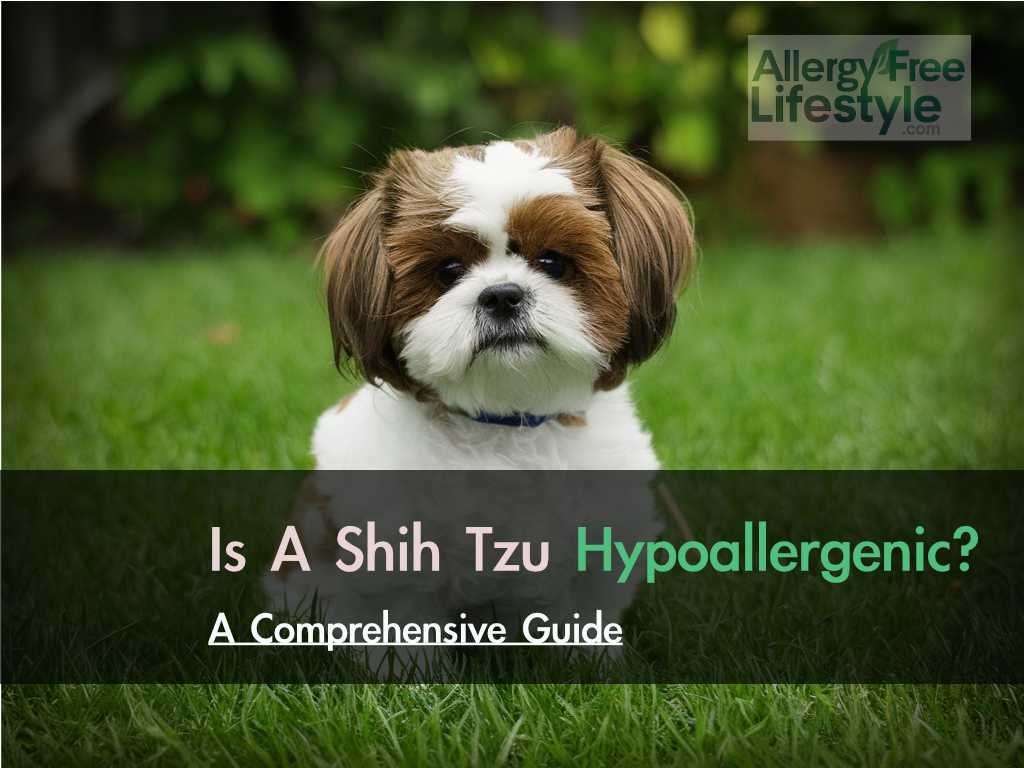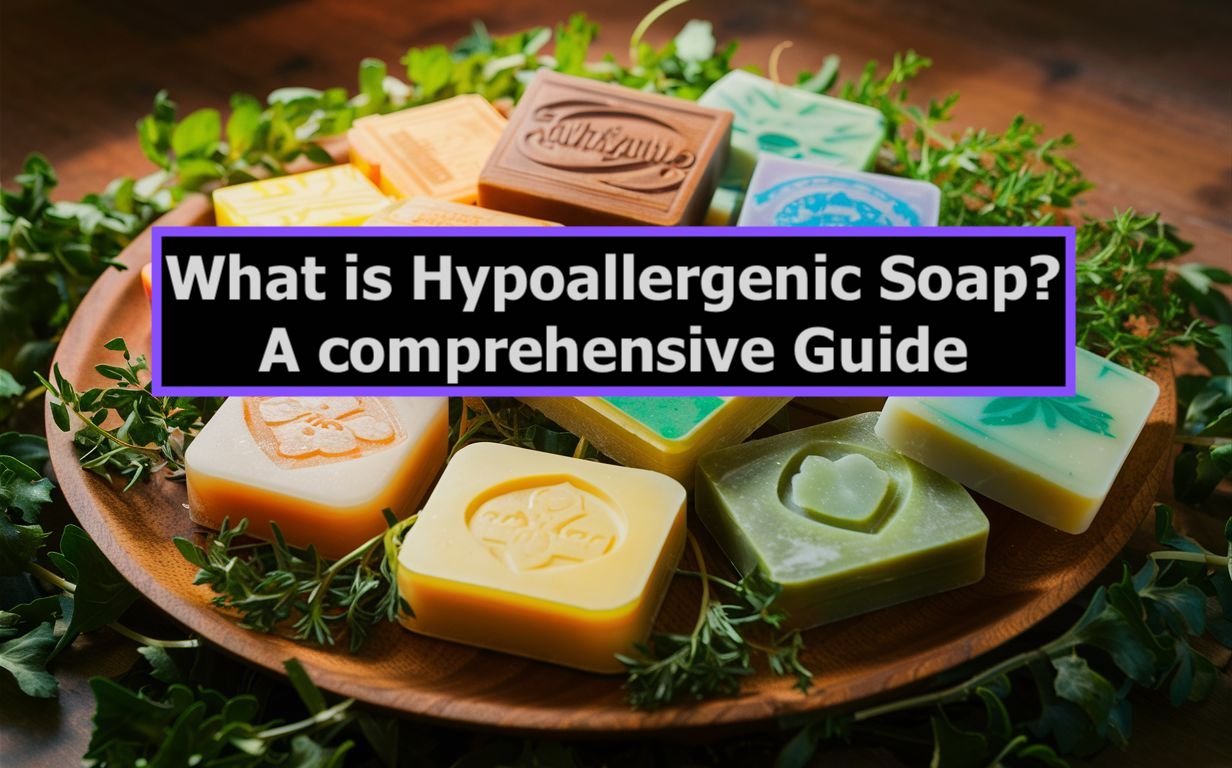Many people dream of sharing their lives with a canine companion, one of the hypoallergenic dogs, because of the significant hurdles presented by allergies from non-hypoallergenic dogs. Unfortunately enough, the term “hypoallergenic dogs.” gets thrown about a lot and is lost in translation, but what exactly does it mean?
Here’s the truth: no such thing as a truly hypoallergenic dog exists. All dogs produce allergens – proteins found in their dander (dead skin flakes), saliva, and urine. These allergens can trigger reactions in people with dog allergies, causing symptoms like sneezing, itchy eyes, runny nose, and even wheezing.
So, if no dog is truly hypoallergenic, why do some breeds get this label? It all boils down to two key factors: shedding and dander.
- Shedding: Some breeds shed very little fur, while others leave a constant trail of fur wherever they go. Less shedding translates to less fur in the environment, reducing the amount of allergens circulating in the air.
- Dander: Dander, not fur, is the real culprit behind dog allergies. Dander flakes off a dog’s skin and easily becomes airborne, sticking to clothes, furniture, and carpeting. Certain dog breeds, particularly those with hair that continuously grows (like poodles) tend to produce less dander than breeds with fur that sheds.
Understanding Pet Allergies
To understand why some people experience dog allergies, let’s take a quick dive into the immune system. When a person with dog allergies encounters allergens, their immune system mistakenly identifies them as a threat. This triggers the release of histamines, chemicals that cause allergy symptoms like inflammation, itching, and irritation.
The Benefits of Choosing a Hypoallergenic Dog
While no dog is completely allergen-free, opting for a breed known for low shedding and dander production can significantly improve the quality of life for allergy sufferers. Here’s how:
- Reduced Allergy Symptoms: By minimizing exposure to allergens, hypoallergenic dogs can help reduce allergy symptoms, allowing individuals to enjoy the companionship of a canine friend without constant sniffles and itchy eyes.
- Improved Quality of Life: Living with fewer allergy symptoms can lead to a noticeable and substantial improvement in overall well-being. People can enjoy playtime with their dogs, cuddle on the couch, and participate in activities they might have previously avoided due to allergies.
- Deeper Human-Animal Bond: Studies have shown that owning a dog can provide numerous emotional and social benefits. When allergies are manageable, a stronger bond can develop between humans and their canine companions.
Who Should Consider Hypoallergenic Dogs?
If you find yourself constantly battling allergens and allergy symptoms around dogs, a hypoallergenic breed might be a good option to explore. Here are some key groups who can benefit from considering a low-shedding, low-dander dog:
- Individuals with Allergies to Dog Dander: This is the most obvious group. People who experience allergy symptoms like sneezing, itching, and watery eyes when around dogs might find relief by choosing a hypoallergenic breed.
- Families with Children Who Have Allergies: Children can be especially sensitive to dog allergens. A hypoallergenic dog can allow families with children who have allergies to enjoy the benefits of pet ownership without compromising their health.
- Anyone Seeking a Low-Shedding Dog Breed: Even if you don’t have allergies, a low-shedding dog can be a real lifesaver when it comes to keeping your home clean. Less fur floating around means less vacuuming and dusting.
Choosing a hypoallergenic dog is a great first step, but it’s important to remember that it’s not a guaranteed solution. Managing expectations and creating a hypoallergenic environment are also crucial aspects of living comfortably with a dog if you have allergies. We’ll delve deeper into these aspects in later sections.
Popular & Best Hypoallergenic Dog Breeds
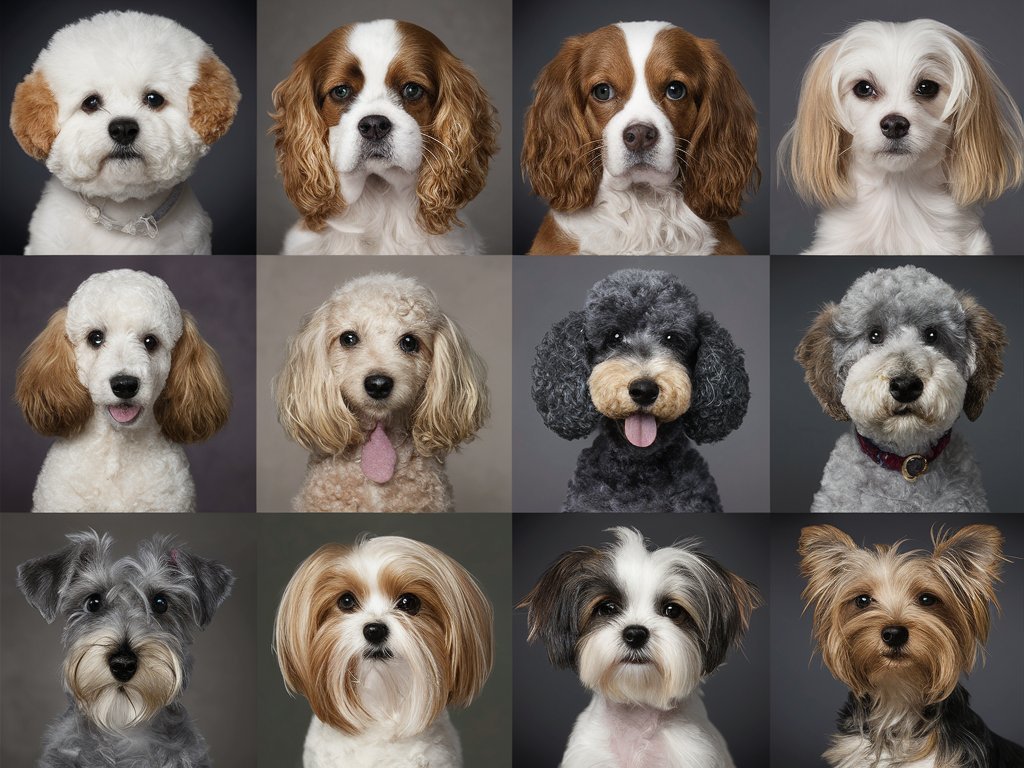
The hunt for the perfect hypoallergenic companion leads us to a delightful world of diverse dog breeds, each with its unique charm and personality. While no breed is truly hypoallergenic, some stand out for their low-shedding coats and minimal dander production. Here, we’ll explore some of the most popular and truly best hypoallergenic dog breeds, categorized by their recognized American Kennel Club (AKC) groups:
Hypoallergenic Dog Breeds List #1 – Poodle Group: Intelligence, Trainability, and Poodle Curls
Poodles are widely recognized as one of the most hypoallergenic dog breeds. These intelligent and athletic dogs come in three distinct sizes: Standard Poodle, Miniature Poodle, and Toy Poodle. All three varieties boast a single coat of curly hair that grows continuously and sheds minimally. Poodles require regular grooming to prevent matting, but this also helps manage dander by removing loose hair and skin flakes.
Standard Poodle:
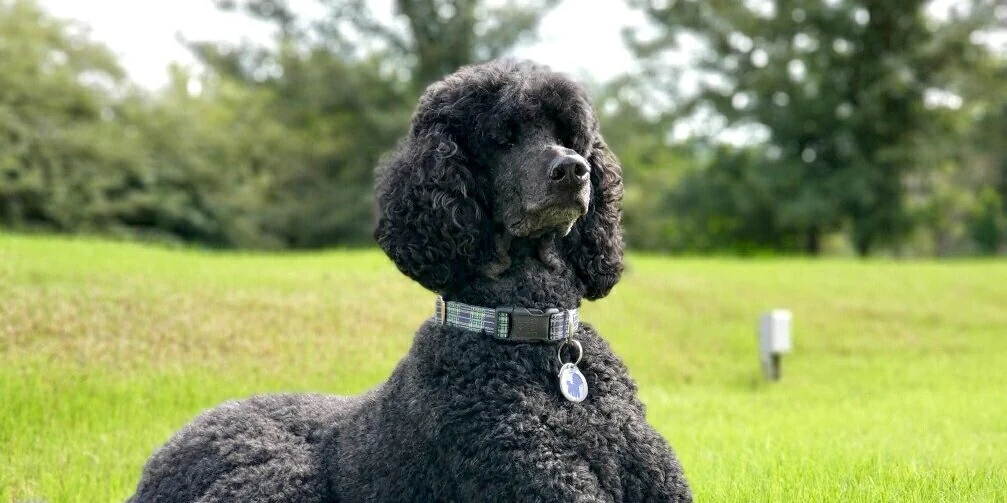
The original poodle, or the Standard Poodle, is an elegant and majestic breed known for its intelligence and trainability. These large dogs excel in obedience training and agility courses, making them a great choice for active families looking for a hypoallergenic dog that sheds minimally and won’t have allergens flying around here and there.
Miniature Poodle:
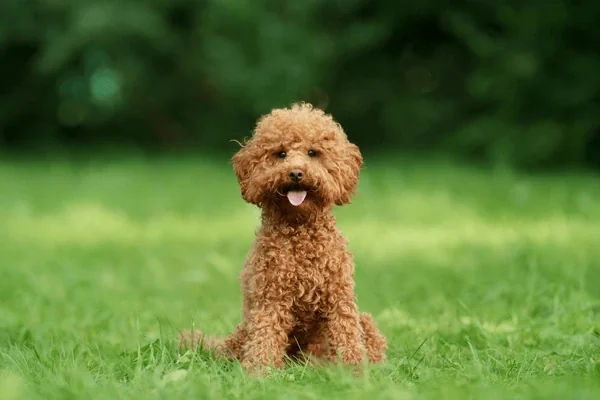
A smaller version (think Audi Q7 and Audi Q3) of the Standard Poodle, the Miniature Poodle retains the intelligence and trainability of its larger cousin in a more compact package. This makes them popular choices for apartment dwellers and families with limited space who still want to have a hypoallergenic dog around the apartment.
Toy Poodle:
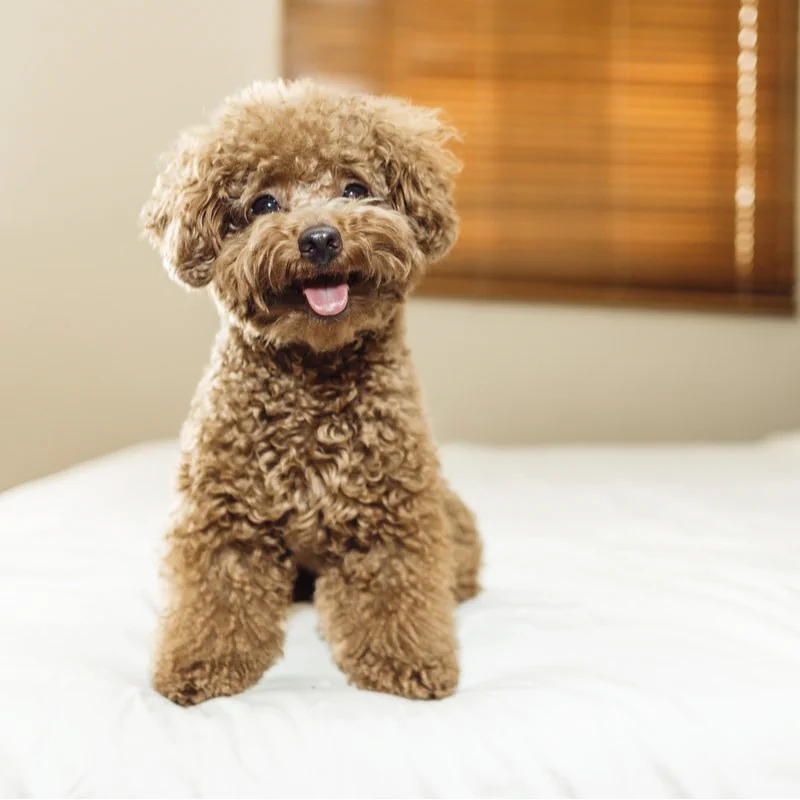
The smallest of the poodle varieties, the Toy Poodle is a charming and social companion dog and has a really cute and befitting name. Don’t let their size fool you, though! Toy Poodles are just as intelligent and playful as their larger counterparts. They are the best hypoallergenic dogs for small families or families with smaller kids who also happen to live in an apartment.
Hypoallergenic Dog Breeds Sub-List #2 – Poodle Mixes (Goldendoodles, Labradoodles, etc.):

The popularity of poodles has led to the rise of designer dogs, also known as doodles. These mixes combine the “hypoallergenic dog” coat of a poodle with the desired traits of another breed, such as the friendly nature of a Golden Retriever or the outgoing personality of a Labrador Retriever. It’s important to note that the coat type and shedding level of a doodle mix can vary depending on the specific parent breeds.
Hypoallergenic Dog Breeds List #2 Terrier Group: Energetic, Playful, and Distinct Personalities
The terrier group offers a variety of hypoallergenic options for those seeking lively and spirited companions. These breeds typically have wiry or non-shedding coats that require regular grooming for maintenance of their appearance and management of dander.
Yorkshire Terrier (Yorkie):
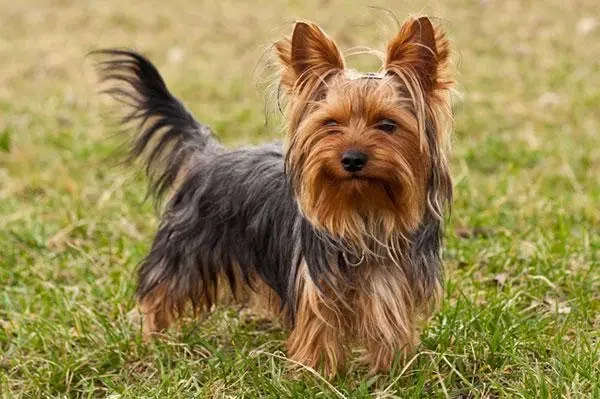
These tiny terriers with silky, flowing hair are known for their feisty personalities and unwavering loyalty. Yorkies are relatively low-maintenance in terms of shedding but require regular brushing to prevent tangles.
Maltese:
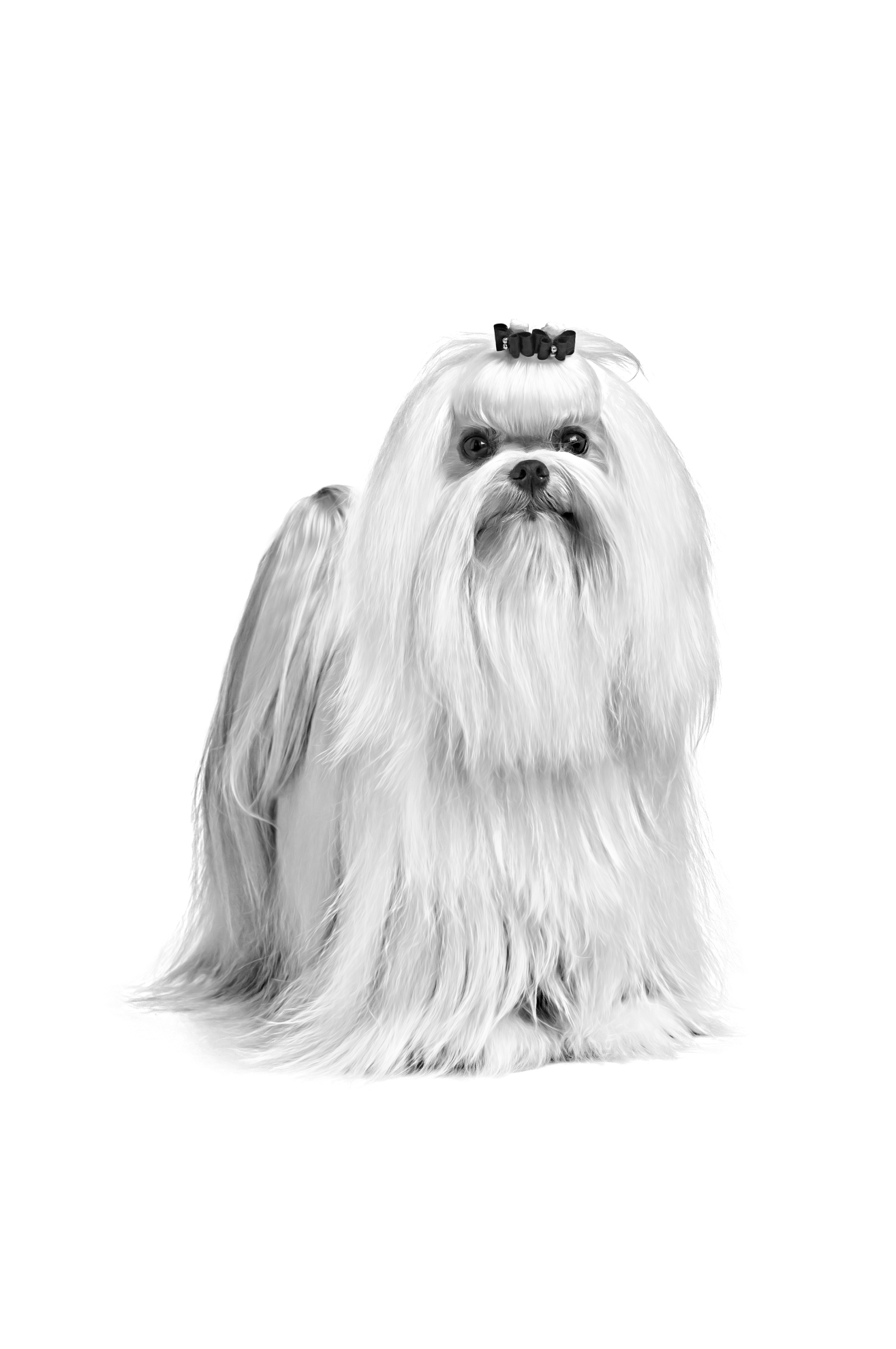
Maltese are adorable lapdogs with long, white flowing coats. These gentle and affectionate companions are well-suited for calm environments and do well in apartments. Regular brushing and trips for professional grooming sessions are essential to maintain their luxurious coat.
Bichon Frise:

Often mistaken for a Maltese, the Bichon Frise boasts a cloud-like white coat and a cheerful, playful temperament. These happy-go-lucky dogs are relatively low-shedding but require regular brushing to prevent matting.
Shih Tzu:

Shih Tzus are known for their distinctive long hair and friendly, playful personalities. These charming little companions require moderate grooming, with regular brushing and occasional professional trims.
Schnauzer Group (Standard Schnauzer, Miniature Schnauzer, Giant Schnauzer):

Schnauzers come in three sizes: standard, Miniature, and Giant. All three varieties share a distinctive wiry coat that sheds minimally. They are intelligent and loyal working dogs that require regular brushing and professional stripping to maintain their signature coat.
West Highland White Terrier (Westie):

Westies are charming white terriers with a reputation for being independent and spirited. Their harsh white coat sheds minimally but requires regular brushing and professional stripping to prevent matting.
Affenpinscher:

Affenpinschers, also known as monkey terriers, are small dogs with a playful and curious nature. Their wiry black coat sheds minimally but requires regular brushing to maintain its texture. They are probably one of the cutest and most playful hypoallergenic dogs out there!
Hypoallergenic Dog Breeds List #3 Non-Sporting Group With Varying Activity Levels
The non-sporting group encompasses a wide range of breeds with diverse appearances and activity levels. Several breeds within this group are known for their hypoallergenic qualities.
Xoloitzcuintli (Xolo):
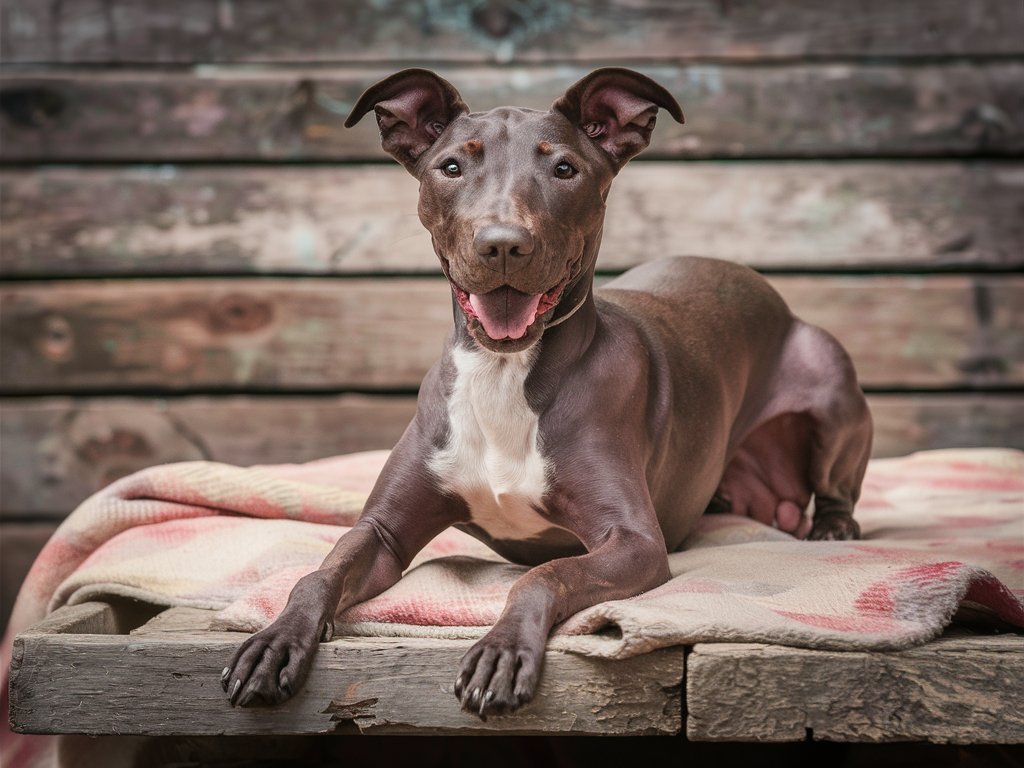
Xolos, also known as Xoloitzcuintlis, are hairless or minimally haired Mexican breed with a unique appearance. These intelligent and loyal dogs come in a variety of sizes, from toy to giant. Hairless Xolos require minimal grooming, while coated Xolos have a short, smooth coat that sheds minimally but still benefits from regular brushing.
Chinese Crested:
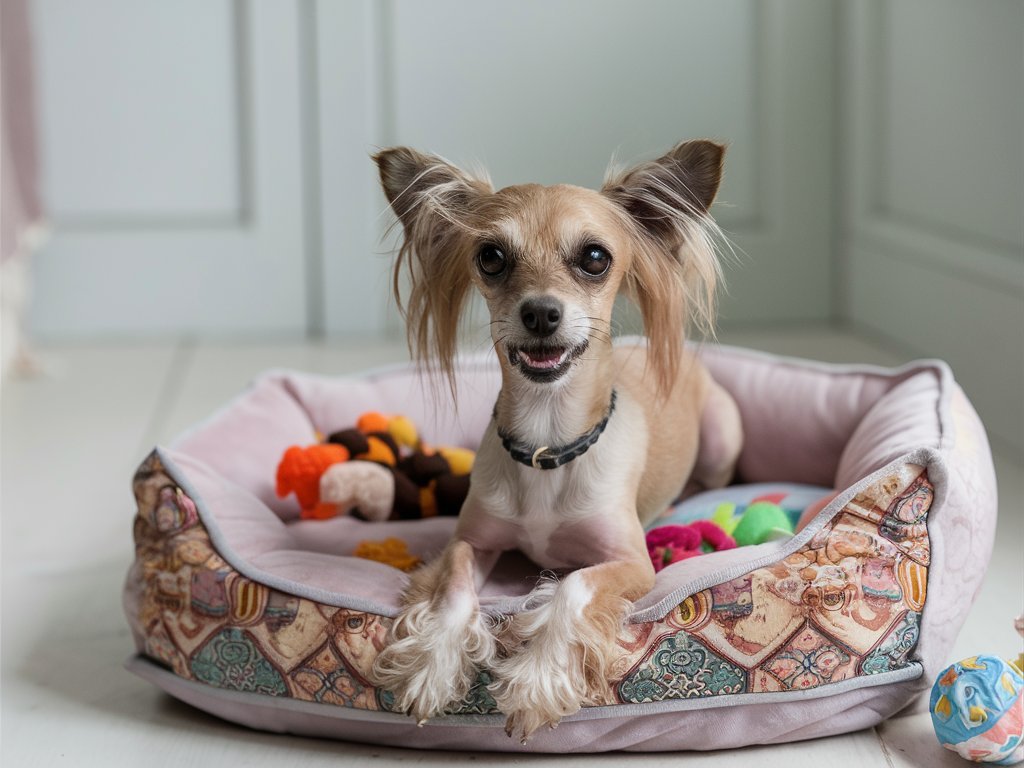
The Chinese Crested comes in two varieties: hairless and powderpuff. Hairless Chinese Cresteds are known for their distinctive appearance and gentle personalities. Powderpuff Chinese Cresteds have a long, silky coat that requires regular brushing and grooming. Both varieties are considered hypoallergenic due to minimal shedding.
Coton de Tulear (Coton):

Also known as the “cotton ball dog,” the Coton de Tulear boasts a fluffy white coat and a gentle temperament. These charming companions are relatively low-shedding but require regular brushing to prevent matting (tangled clumps of a dog’s fur—equivalent to human tangled hair or dreadlocks) and maintain their soft coat.
Havanese:
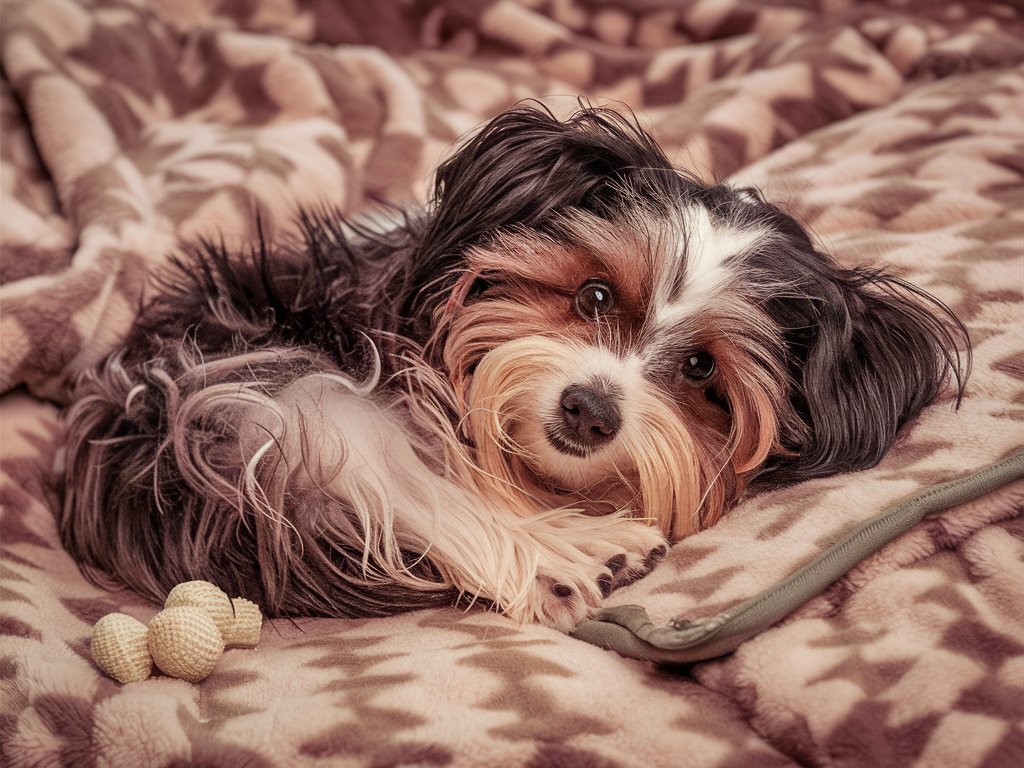
Havanese are known for their silky hair, affectionate personalities, and signature “happy dance.” These playful dogs are relatively low-shedding but require regular brushing to keep their coats tangle-free.
Lhasa Apso:
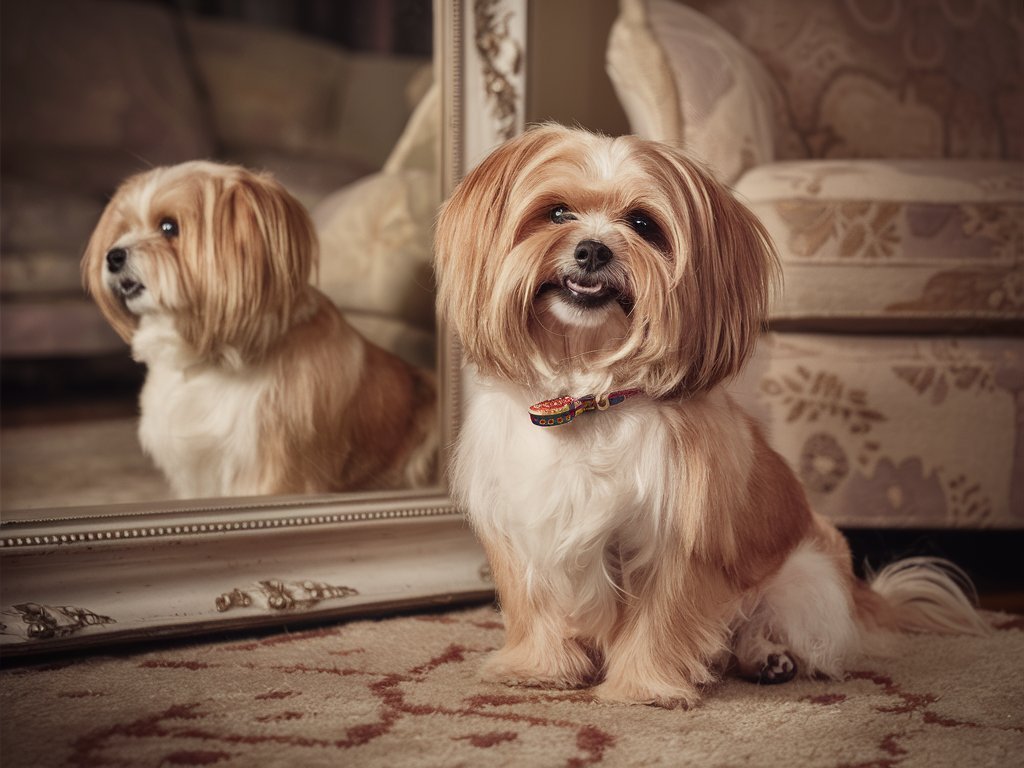
Lhasa Apsos are alert and independent dogs with a long, flowing coat. These regal companions were originally bred as Tibetan temple guard dogs. Their thick double coat requires consistent regular brushing and professional grooming to prevent matting.
Bolognese:
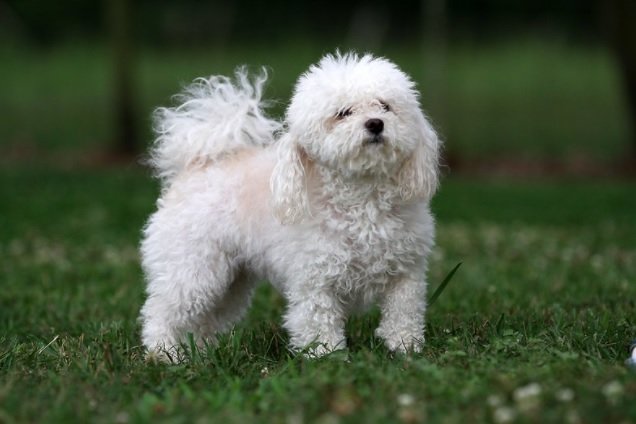
Often mistaken for a Bichon Frise, the Bolognese shares a similar fluffy white coat and calm, cuddly personality. These gentle dogs are relatively low-shedding but require regular brushing to maintain their coat.
Hypoallergenic Dog Breeds List #4 Hound & Sporting Group: Less Common Hypoallergenic Options
While less common than the breeds mentioned above, some hound and sporting dogs can also be suitable companions for allergy sufferers. It’s important to note that these breeds may require more frequent grooming to manage dander.
Irish Water Spaniel:
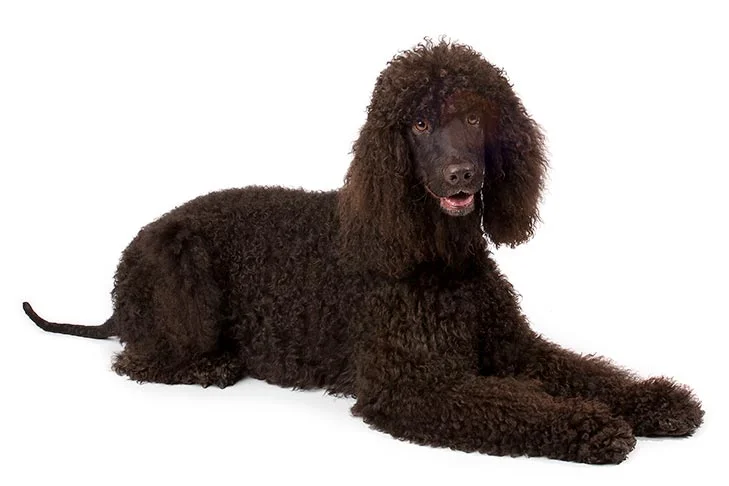
Irish Water Spaniels are energetic and athletic dogs with distinctive curly coats. Their single coat sheds minimally but requires regular brushing and professional grooming to prevent matting.
Portuguese Water Dog:
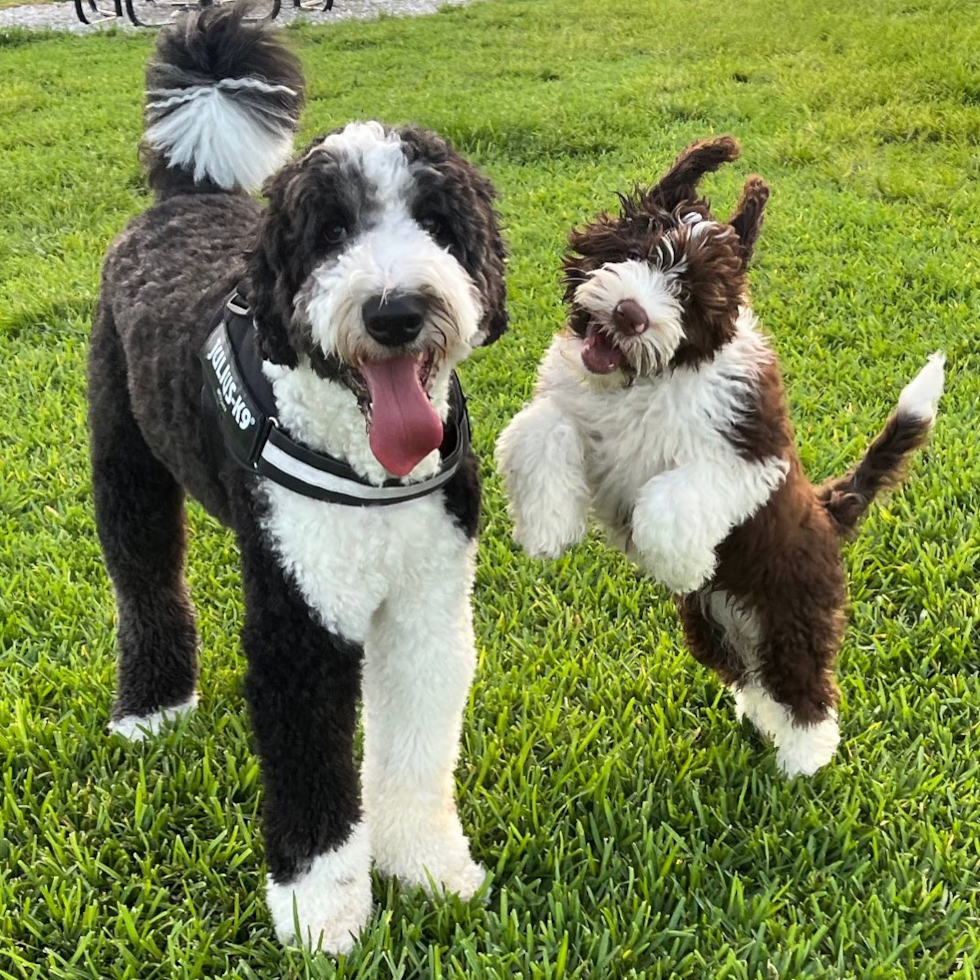
These intelligent and athletic dogs were originally bred to assist fishermen’s companions in Portugal. Their dense, double coat sheds minimally but requires regular brushing and professional grooming to maintain its waterproof qualities.
Afghan Hound:
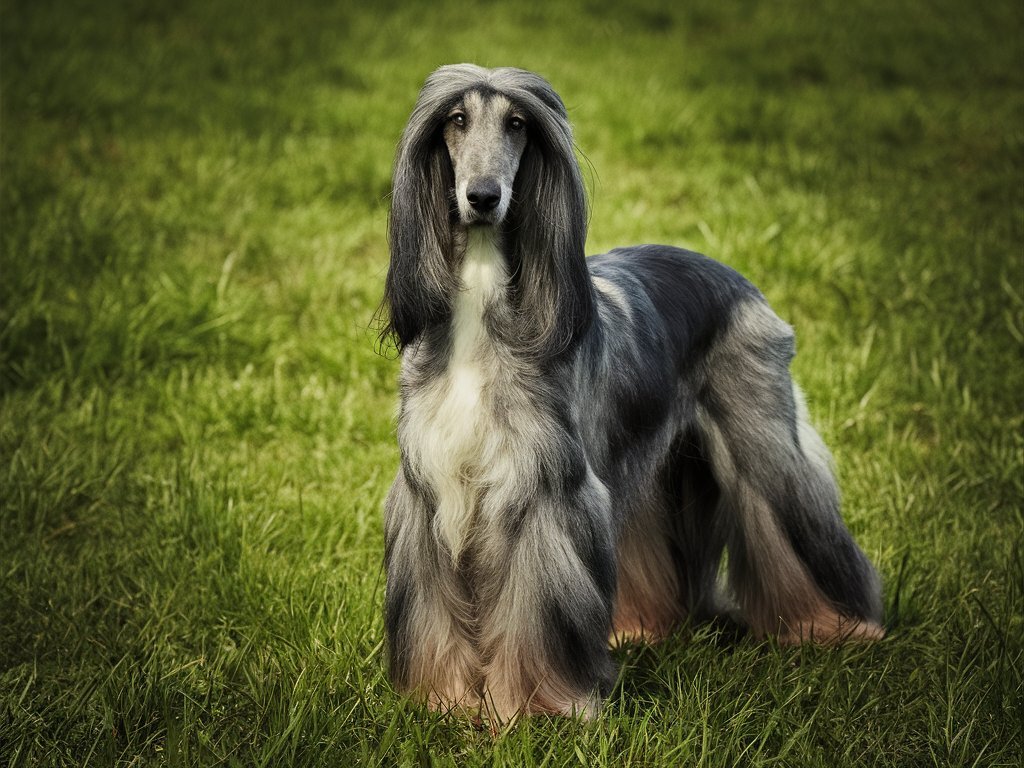
Afghan Hounds are elegant sighthounds known for their luxurious, flowing coat. While undeniably beautiful, the Afghan Hound’s coat requires a significant commitment in terms of brushing and professional grooming to prevent matting.
Remember: This list highlights some of the most popular and best hypoallergenic dog breeds. Individual variations exist within breeds. Meeting a specific dog before bringing it home can be a good way to gauge potential shedding levels and your allergy response.
Choosing the Right Breed for You:
Having explored this diverse range of hypoallergenic dog breeds, the next step is to consider which one might be the best fit for you and your lifestyle. In the next section, we’ll delve deeper into factors affecting hypoallergenicity beyond breed, including shedding vs. dander and grooming routines for different coat types.
Beyond Breed: Factors Affecting Hypoallergenicity
While breed selection is a crucial starting point, several other factors can influence the overall hypoallergenicity of living with a dog. Here, we’ll explore some key concepts that go beyond breed to create a more allergy-friendly environment for you and your furry friend.
A. Shedding vs. Dander: Understanding the Culprit
Many people mistakenly believe that shedding is the primary cause of dog allergies. In reality, the true culprit behind allergy symptoms is dander, not fur itself. Dander consists of dead skin flakes that naturally shed from a dog’s body. These tiny flakes can become airborne, easily attaching themselves to clothes, furniture, and carpeting. When inhaled, dander triggers allergy symptoms in people who are sensitive.
So, how does shedding relate to dander?
- High-Shedding Breeds: Dogs that shed frequently release more fur into the environment. This fur can trap dander flakes, increasing their circulation throughout the house.
- Low-Shedding Breeds: Breeds with minimal shedding release less fur, reducing the overall amount of dander circulating in the air. However, even low-shedding dogs still produce dander, so other management strategies are necessary.
B. Coat Type and Grooming Considerations
The type of coat a dog has also plays a role in dander production and management. Here’s a breakdown of some common coat types and their impact on allergies:
- Hair vs. Fur: Dogs with hair, like poodles and bichon frises, have a single coat that grows continuously and sheds minimally. This continuous growth helps trap dander near the skin, minimizing its release into the air. Regular grooming, including brushing and professional trims, is essential for removing loose hair and dander.
- Double Coat: Some breeds, such as Huskies and Labrador Retrievers, have a double coat consisting of a dense undercoat and a longer topcoat. This double coat sheds seasonally, releasing large amounts of fur and trapped dander. While double-coated dogs are not typically considered hypoallergenic, frequent brushing, especially during shedding seasons, can help manage dander.
C. Individual Variations Within Breeds
It’s important to remember that even within breeds considered hypoallergenic, individual variations can exist. Factors like overall health, diet, and even genetics can influence the amount of dander a dog produces.
- Meeting the Dog: Before bringing a dog home, especially if you have allergies, consider spending time with the specific dog you’re interested in. This allows you to gauge your individual allergic reaction and assess their shedding level.
D. Management Strategies for a More Hypoallergenic Home
Here are some practical strategies you can implement to create a more hypoallergenic home environment, regardless of the breed you choose:
- Frequent Vacuuming: Regularly vacuum carpets, rugs, and upholstered furniture using a HEPA filter vacuum cleaner. HEPA filters trap tiny particles like dander, preventing them from recirculating in the air.
- Washing Bedding and Linens: Wash bedding, blankets, and throw pillows frequently in hot water (at least 130°F or 54°C) to kill dust mites and remove allergens.
- Bathing the Dog: Consult your veterinarian about an appropriate bathing schedule for your dog. Frequent baths can remove dander and allergens from the skin’s surface. However, over-bathing can cause drier skin and worsen allergies.
- Keeping the Dog Off Furniture: Discourage your dog from getting on furniture, especially beds and couches. This helps minimize dander transfer to areas where you spend a lot of time.
- Air Purifiers: Consider using air purifiers with HEPA filters in your home. These can help capture airborne allergens, including dander, dust mites, and pollen.
Remember: These strategies work best when implemented consistently. By creating a routine of cleaning, managing your dog’s coat, and establishing boundaries, you can significantly reduce allergens in your home and enjoy a happier, healthier allergy-free lifestyle with your canine companion.
In the next section, we’ll delve into the process of choosing the right hypoallergenic dog for you. We’ll explore factors like lifestyle, activity level, and grooming commitment to help you find the perfect furry friend who fits seamlessly into your life and minimizes allergy triggers.
Choosing the Right Hypoallergenic Dog for You
Finding the perfect hypoallergenic dog is a journey that combines your love for canines with the practicalities of managing allergies. Here, we’ll explore some key considerations to ensure you find a furry friend who complements your lifestyle and minimizes allergy triggers.
A. Matching Your Lifestyle with the Dog’s Needs
Not all dogs are created equal! Different breeds have varying activity levels, grooming requirements, and temperaments. Choosing a dog that aligns with your lifestyle sets the stage for a happy and harmonious relationship.
- Consider Your Activity Level: Do you crave a jogging buddy or a cuddly lapdog companion? High-energy dogs like Poodles and Schnauzers require plenty of exercise, while calmer breeds like Bichon Frises and Shih Tzus are content with shorter walks and playtime indoors.
- Think About Your Living Situation: Apartment dwellers might do better with smaller breeds like Yorkshire Terriers or Maltese. Larger breeds like Standard Poodles or Portuguese Water Dogs require more space to roam and expend their energy.
- Evaluate Your Grooming Commitment: Some hypoallergenic breeds, like poodles and bichon frises, require regular brushing and professional grooming to maintain their coats and manage dander. If you have a busy lifestyle, consider a breed with a low-maintenance coat like a Havanese or a Coton de Tulear.
B. Selecting a Reputable Breeder or Rescue
Finding your hypoallergenic companion can happen through two main avenues: reputable breeders or shelters/rescues. Here’s what to consider for each option:
- Reputable Breeders:
- Importance of ethical breeding practices that prioritize health and temperament testing of parent dogs.
- Breeders can provide information about specific puppies’ temperaments and potential shedding levels.
- Be prepared for a waiting list and potentially higher adoption fees.
- Shelters/Rescues:
- Many shelters and rescues have mixed breed dogs that may exhibit hypoallergenic qualities.
- Adoption fees are typically lower than from breeders.
- The dog’s history and temperament might be less predictable, and shedding levels can vary.
Here are some tips for finding a reputable breeder or rescue:
- Ask for recommendations: Talk to veterinarians, groomers, or dog owners you know for recommendations on reputable breeders or shelters.
- Do your research: Research different breeds to find one that aligns with your lifestyle and allergy needs.
- Visit breeders/shelters: Schedule visits to breeders or shelters to meet the dogs and ask questions about their health, temperament, and potential shedding levels.
C. Meeting the Dog Before Bringing Them Home
Regardless of whether you choose a breeder or a rescue, meeting the dog before bringing them home is crucial, especially if you have allergies. Spending time with the dog allows you to:
- Gauge your allergic reaction: See how your allergies respond to interacting with the specific dog.
- Assess their temperament: Observe the dog’s personality and energy level to ensure they fit your lifestyle.
- Ask questions: Talk to the breeder or shelter staff about the dog’s history, grooming needs, and any potential health concerns.
By carefully considering these factors, you can choose a hypoallergenic dog who becomes a cherished member of your family while minimizing allergy triggers in your home.
Living with a Hypoallergenic Dog
Bringing home a new dog, hypoallergenic or not, is an exciting adventure. However, for allergy sufferers, additional considerations come into play to ensure a smooth coexistence. This section explores essential aspects of living with a hypoallergenic dog, from training and socialization to grooming routines and maintaining a healthy coat.
A. Training and Socialization Practices and Routines
Training and socialization are crucial for all dogs, regardless of breed. A well-trained dog is a joy to live with and easier to manage, especially when it comes to minimizing allergy triggers.
- Obedience Training: Basic obedience training commands like “sit,” “stay,” and “come” provide a foundation for good communication and control. A well-trained dog is less likely to jump on furniture or shed excessively due to excitement.
- Socialization: Early socialization exposes your dog to different people, animals, and environments. This helps them develop confidence and prevents fear-based behaviors that can trigger allergies (e.g., excessive licking or scratching).
Here are some resources for dog training and socialization:
- American Kennel Club (AKC) – Dog Training: https://www.akc.org/products-services/training-programs/
- The Association of Professional Dog Trainers: https://apdt.com/
- The American Society for the Prevention of Cruelty to Animals (ASPCA) – Socialization of Puppies: https://www.aspcapro.org/resource/tips-socializing-puppy
B. Grooming Routines for Hypoallergenic Dogs
Regular grooming is paramount for the maintenance of a healthy coat and for minimizing dander production in hypoallergenic dogs. The specific grooming requirements will vary depending on the breed and coat type. Here’s a general breakdown:
- Brushing Frequency: Most hypoallergenic breeds benefit from regular brushing, ranging from daily for poodles to a few times a week for Bichon Frises and Coton de Tulear. Brushing removes loose hair and dander before it has a chance to shed and become airborne.
- Bathing: Consult your veterinarian about an appropriate bathing schedule for your dog. Frequent baths can remove dander but can also dry out the skin. A veterinarian can recommend hypoallergenic shampoos suitable for sensitive skin.
- Ear Cleaning and Nail Trimming: Regular ear cleaning and nail trimming are quite vital for maintaining your dog’s overall health and hygiene. Improper ear cleaning can lead to infections, while untrimmed nails can become uncomfortable and cause your dog to scratch, potentially worsening allergies.
Here are some additional grooming tips for hypoallergenic dogs:
- Use a slicker brush or a grooming comb specifically designed for your dog’s coat type.
- Brush your dog outdoors whenever possible to minimize dander spread indoors.
- After brushing, wipe down your dog with a damp cloth to remove any remaining loose hair and dander.
- Consider professional grooming services every few months for breeds with more complex coat needs.
C. Maintaining a Healthy Coat
A healthy coat is not only aesthetically pleasing but also contributes to overall skin health and minimizes dander production. Here are some ways to promote a healthy coat in your hypoallergenic dog:
- Diet: A high-quality diet rich in omega-3 fatty acids can nourish the skin and coat, promoting shine and reducing shedding.
- Supplements: Consult your veterinarian about omega-3 fatty acid supplements if your dog’s diet lacks these essential nutrients.
- Parasite Prevention: Regular flea and tick prevention is crucial for maintaining healthy skin and preventing scratching, which can exacerbate allergies.
By establishing a consistent grooming routine and prioritizing your dog’s overall health, you can significantly reduce dander production and create a more allergy-friendly environment for yourself and your furry companion.
Additional Considerations for Allergy Sufferers
Living with a dog, even a hypoallergenic one, can still trigger allergies in some individuals. This section offers additional advice for allergy sufferers who share their homes with pets.
A. Consulting an Allergist
If you have allergies and are considering getting a dog, even a hypoallergenic breed, consulting with an allergist is a wise first step. An allergist can:
- Perform Allergy Testing: Allergy testing can identify the specific allergens you react to, including dog dander. This helps determine the severity of your allergies and the potential impact of living with a dog.
- Develop an Allergy Management Plan: An allergist can create a personalized plan to manage your allergies, including medication recommendations and strategies for minimizing allergen exposure in your home.
B. Living with Other Pets
What if you already have pets but also dream of canine companionship? Here are some options to consider:
- Hypoallergenic Cats: Certain cat breeds, such as Sphynx cats and Siberian Forest cats, are known for producing less dander, making them potentially suitable companions for some allergy sufferers.
- Small Animals: Small animals like guinea pigs or rabbits can be alternative pet choices for individuals with severe dog allergies. However, it’s important to note that these animals can also produce allergens.
Here are some tips for minimizing allergen exposure from existing pets:
- Limit Pet Access to Certain Areas: Designate pet-free zones in your home, particularly your bedroom.
- Regular Cleaning: Maintain a consistent cleaning routine, including frequent vacuuming, washing bedding, and wiping down surfaces.
- Air Purifiers: Consider using air purifiers with HEPA filters in your home to capture allergens.
C. Remember: There’s no guarantee that even a hypoallergenic dog won’t trigger allergies in some individuals. Consulting with an allergist, exploring alternative pet options if necessary, and implementing allergen-reduction strategies can significantly improve your quality of life and allow you to enjoy the companionship of a furry friend.
Conclusion – Choose the Best Hypoallergenic Dog
Living with a dog, hypoallergenic or not, requires commitment and responsibility. For allergy sufferers, careful planning, breed selection, and a commitment to allergy management are essential for creating a harmonious household. The information presented in this guide is intended to empower you to make informed decisions about canine companionship and navigate the world of hypoallergenic dogs with confidence.
Remember:
- There is no truly hypoallergenic dog, but certain breeds shed less and produce less dander.
- Choose a dog that complements your lifestyle and activity level.
- Find a reputable breeder or rescue and meet the dog before bringing them home.
- Implement a consistent grooming routine and prioritize your dog’s overall health for a healthy coat and minimal dander.
- Consult with an allergist to understand your allergies and develop a management plan.
By following these steps, you can create a loving and enriching environment for both yourself and your furry companion, even if allergies are a part of your life.
Owning a dog is a rewarding experience, and with careful planning and proactive management, allergies needn’t stand in the way of enjoying the companionship of a canine friend.
Resources and Further Reading
This guide has explored various aspects of hypoallergenic dogs, from breed selection and management strategies to living with allergies and pets. The following resources can provide further information and support on your journey:
- American Kennel Club (AKC): The AKC is a national organization dedicated to purebred dogs. Their website offers a wealth of information on breeds, including details on grooming needs and potential shedding levels. https://www.akc.org/
- The Association of Professional Dog Trainers (APDT): The APDT is a professional organization for dog trainers. Their website provides resources on finding a qualified trainer in your area and information on dog training methods. https://apdt.com/
- The American Society for the Prevention of Cruelty to Animals (ASPCA): The ASPCA is a nonprofit organization dedicated to animal welfare. Their website offers a variety of resources on pet care, including information on dog allergies and pet adoption. https://www.aspca.org/
- National Institute of Allergy and Infectious Diseases (NIAID): Part of the National Institutes of Health (NIH), the NIAID website provides information on allergies, including pet allergies and allergy management strategies. https://www.niaid.nih.gov/
Remember:
The information provided in this guide is intended to be educational and informative. It is not a substitute for professional veterinary advice. Always consult with your veterinarian to discuss your allergies and determine the best approach for bringing a dog into your life.
By utilizing the resources listed above and partnering with your veterinarian, you can make informed decisions about canine companionship and embark on a joyful journey with your hypoallergenic furry friend.
Glossary of Terms
This glossary provides definitions for some key terms used throughout this guide to hypoallergenic dogs:
- Allergen: A substance that triggers an allergic reaction in people who are sensitive to it. In the case of dog allergies, the allergens are proteins found in dog dander, saliva, and urine.
- Allergic Reaction: The body’s response to an allergen, which can cause symptoms like sneezing, itching, runny nose, watery eyes, and even wheezing.
- American Kennel Club (AKC): The national organization for purebred dogs in the United States.
- Dander: Flakes of dead skin naturally shed by animals. Dander is the primary culprit behind dog allergies, as it can become airborne and inhaled by people who are sensitive.
- Double Coat: A type of fur consisting of a dense undercoat and a longer topcoat. Double-coated breeds typically shed seasonally in large amounts.
- Grooming: The process of caring for a dog’s coat, including brushing, bathing, ear cleaning, and nail trimming.
- Hair vs. Fur: Hair, like that found on poodles and bichon frises, grows continuously and sheds minimally. Fur, on the other hand, sheds seasonally.
- Hepa Filter: A high-efficiency particulate air filter that traps tiny particles like allergens, dust mites, and pollen.
- Hypoallergenic: A term used to describe something that is less likely to cause an allergic reaction. While no dog is truly hypoallergenic, some breeds produce less dander and shed less fur, potentially reducing allergy triggers.
- Immune System: The body’s natural defense system that protects against infections and illnesses. In people with allergies, the immune system mistakenly identifies allergens as a threat, triggering an allergic reaction.
- Shedding: The natural process of losing fur or hair. While all dogs shed to some extent, hypoallergenic breeds typically shed minimally.
- Single Coat: A type of fur where the hair grows continuously and sheds minimally.
FAQ: Hypoallergenic Dogs
1. Is a Cavapoo hypoallergenic?
Yes, Cavapoos are considered hypoallergenic due to their Poodle heritage, which tends to shed less and produce fewer allergens.
2. Is a Goldendoodle hypoallergenic?
Yes, goldendoodles are typically hypoallergenic. They combine traits from golden retrievers and Poodles with the latter’s low-shedding coat.
3. Is a Labradoodle hypoallergenic?
Yes, Labradoodles are often hypoallergenic, inheriting the Poodle’s low-shedding coat.
4. Is a Shih Tzu hypoallergenic?
Yes, Shih Tzus are considered one of the best hypoallergenic dogs because they have hair that sheds less than typical dog fur.
5. Is a Yorkie hypoallergenic?
Yes, Yorkshire Terriers (Yorkies) are considered hypoallergenic due to their hair-like coat that sheds very little.
6. Is a Cockapoo hypoallergenic?
Yes, Cockapoos are considered hypoallergenic, thanks to their Poodle ancestry, resulting in a low-shedding coat.
7. Is a Pomeranian hypoallergenic?
No, Pomeranians are not considered hypoallergenic as they shed moderately.
8. Is the Maltese hypoallergenic dog?
Yes, Maltese dogs are considered hypoallergenic due to their minimal shedding.
9. Is a Maltipoo hypoallergenic?
Yes, Maltipoos are generally hypoallergenic, benefiting from the low-shedding qualities of their Poodle parent.
10. Is a Cocker Spaniel hypoallergenic?
No, Cocker Spaniels are not considered hypoallergenic due to their tendency to shed.
11. Is a Bernedoodle hypoallergenic?
Yes, Bernedoodles tend to be hypoallergenic, inheriting the Poodle’s low-shedding coat characteristics.
12. Is a Dachshund hypoallergenic?
No, Dachshunds are not considered hypoallergenic due to their moderate shedding.
13. Is a French Bulldog hypoallergenic?
No, French Bulldogs are not considered hypoallergenic as they shed and can produce more allergens.
14. Is a Maine Coon hypoallergenic?
No, Maine Coon cats are not hypoallergenic; they have long fur and can shed considerably.
15. Is a Schnauzer hypoallergenic?
Yes, Schnauzers are considered hypoallergenic due to their wiry coat that sheds very little.
16. Is Bichon Frise hypoallergenic dog?
Yes, Bichon Frise dogs are considered hypoallergenic thanks to their curly, low-shedding coat.
17. Is a Havanese hypoallergenic?
Yes, Havanese dogs are considered hypoallergenic due to their long, silky hair and low shedding.
18. Is a Poodle hypoallergenic dog?
Yes, Poodles of all sizes are considered hypoallergenic due to their curly, low-shedding coats.
19. Is a Shiba Inu hypoallergenic?
No, Shiba Inus are not considered hypoallergenic; they shed a moderate amount.
20. Is a Samoyed hypoallergenic?
No, despite their fluffy coats, Samoyeds are not considered hypoallergenic. They shed quite a bit.
21. Is a Beagle hypoallergenic?
No, Beagles are not considered hypoallergenic due to their moderate shedding.
22. Is a Chihuahua hypoallergenic?
No, Chihuahuas are not considered hypoallergenic; they shed depending on the coat type.
23. Is a Golden Retriever hypoallergenic dog?
No, Golden Retrievers are not a hypoallergenic dog. They are known for their heavy shedding.
24. Is an Australian Shepherd hypoallergenic?
No, Australian Shepherds are not considered hypoallergenic due to their shedding and dander production.
25. Is a Border Collie hypoallergenic?
No, Border Collies are not considered hypoallergenic due to their high shedding.
26. Is a Boston Terrier hypoallergenic?
No, Boston Terriers are not considered hypoallergenic; they shed and produce dander.
27. Is a Cavalier King Charles Spaniel hypoallergenic?
No, Cavalier King Charles Spaniels are not hypoallergenic due to their moderate shedding.
28. Is a Corgi hypoallergenic?
No, Corgis are not considered hypoallergenic; they shed heavily.
29. Is a Jack Russell Terrier hypoallergenic?
No, Jack Russell Terriers are not considered hypoallergenic due to their shedding.
30. Is a King Charles Spaniel hypoallergenic?
No, King Charles Spaniels are not considered hypoallergenic; they share the same traits as Cavalier King Charles Spaniels.
31. Is a Toy Poodle hypoallergenic?
Yes, Toy Poodles are hypoallergenic, similar to their standard and miniature counterparts, due to their low-shedding coats.
32. Is a Lhasa Apso hypoallergenic?
Yes, Lhasa Apsos are considered hypoallergenic due to their long, dense coat that sheds minimally.
33. Is a Morkie hypoallergenic?
Yes, Morkies can be considered hypoallergenic, blending the traits of Maltese and Yorkshire Terriers, both known for low shedding.
34. Is a Pomsky hypoallergenic?
No, Pomskies are not considered hypoallergenic due to the varied shedding traits inherited from Pomeranians and Huskies.
35. Is a Pug hypoallergenic?
No, Pugs are not considered hypoallergenic; they shed and produce a fair amount of dander.
36. Is a Vizsla hypoallergenic?
No, Vizslas are not considered hypoallergenic, despite being short-haired, due to their moderate shedding.
37. Is a Basenji hypoallergenic?
Yes, Basenjis are often considered hypoallergenic due to their short coat and minimal shedding.
38. Is a Bernese Mountain Dog hypoallergenic?
No, Bernese Mountain Dogs are not hypoallergenic due to their heavy shedding.
39. Is a Doberman hypoallergenic?
No, Dobermans are not considered hypoallergenic; they shed moderately.
40. Is a Mini Goldendoodle hypoallergenic?
Yes, Mini Goldendoodles are generally hypoallergenic, benefiting from the low-shedding characteristics of their Poodle parent.
41. Is a Portuguese Water Dog hypoallergenic?
Yes, Portuguese Water Dogs are considered hypoallergenic due to their curly, low-shedding coat.
42. Is a Rottweiler hypoallergenic?
No, Rottweilers are not considered hypoallergenic; they shed moderately.
43. Is a Sheepadoodle hypoallergenic?
Yes, Sheepadoodles tend to be hypoallergenic, inheriting the Poodle’s low-shedding coat.
44. Is a Shih Poo hypoallergenic?
Yes, Shih Poos are generally considered hypoallergenic, combining the low-shedding traits of Shih Tzus and Poodles.
45. Is a Yorkie Poo hypoallergenic?
Yes, Yorkie Poos are considered hypoallergenic, inheriting the low-shedding qualities of Yorkshire Terriers and Poodles.
46. Is an Aussiedoodle hypoallergenic?
Yes, Aussiedoodles are often hypoallergenic, thanks to the low-shedding coat of the Poodle parent.
47. Is Belgian Malinois hypoallergenic?
No, Belgian Malinois are not considered hypoallergenic; they shed moderately.

